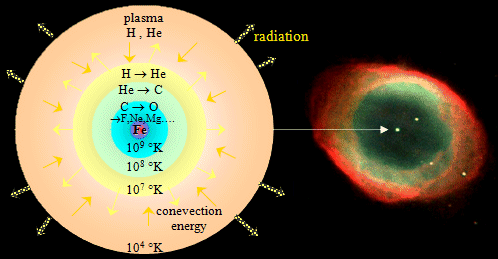Primordial nucleosynthesis and stars - alchemical cauldrons
of the universe
| AstroNuclPhysics ® Nuclear
Physics - Astrophysics - Cosmology
|
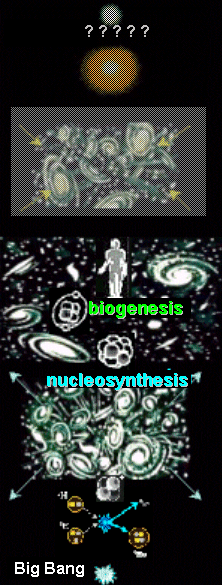 |
COSMIC
NUCLEAR ALCHEMY
and/or
ON THE ORIGIN OF ELEMENTS
| Structure of matter and nuclear
physics |
| Primordial nucleosynthesis at the
beginning of the world |
| Stars - alchemical cauldrons of
universe |
| We are all descendants of the
stars ! |
Vojtech
Ullmann
p h y s i c i s t
In the
lecture on the relationship between nuclear physics and
astrophysics and cosmology, we will approach a fascinating
scenario of the formation of elements in space and the chemical evolution of the
universe at various stages of its evolution.
|
S y l a b u s
NATURE -
NATURAL SCIENCE
| The most
basic questions of science : |
What
is the essence and internal composition of matter ?
What laws govern the duration, motion, and transformation
of matter ?
What is the
essence of the universe ? Did the universe come into
being spontaneously, or was it created by God ? |
MACROWORLD 10 -8 cm <d <10 3 light years
Classical physics (Newtonian mechanics,
thermodynamics, electrodynamics ...)
MICROWORLD - inside the matter d <10 -8 cm
Quantum physics, atomistics, nuclear physics , elementary particles
MEGA-WORLD
- distant universe d > 10 3 light years
Special theory of relativity - high
velocities ® time dilation, length contraction
General theory of relativity - gravity ® curved
spacetime
Astrophysics + Cosmology
Matter -
substance
Basic
question :
What is the essence and internal composition of matter ?
| Divisibility of
substances: |
e
unlimited divisible - continuum |
| î
limited division - structure -
a t o m s |
What is the carrier of
the properties of substances?
Substance properties: alchemy ® chemistry
® physics ; Chemical properties Þ e l e m e n t s
Mendeleev's
periodic table of chemical elements
( elements marked in red are
radioactive - they
do not have stable isotopes) |
H
1 |
|
He
2 |
Li
3 |
Be
4 |
|
B
5 |
C
6 |
N
7 |
O
8 |
F
9 |
Ne
10 |
Na
11 |
Mg
12 |
|
Al
13 |
Si
14 |
P
15 |
S
16 |
Cl
17 |
Ar
18 |
K
19 |
Ca
20 |
Sc
21 |
Ti
22 |
V
23 |
Cr
24 |
Mn
25 |
Fe
26 |
Co
27 |
Ni
28 |
Cu
29 |
Zn
30 |
Ga
31 |
Ge
32 |
As
33 |
Se
34 |
Br
35 |
Kr
36 |
Rb
37 |
Sr
38 |
Y
39 |
Zr
40 |
Nb
41 |
Mo
42 |
Tc
43 |
Ru
44 |
Rh
45 |
Pd
46 |
Ag
47 |
Cd
48 |
In
49 |
Sn
50 |
Sb
51 |
Te
52 |
I
53 |
Xe
54 |
Cs
55 |
Ba
56 |
La .. î
|
Hf
72 |
Ta
73 |
W
74 |
Re
75 |
Os
76 |
Ir
77 |
Pt
78 |
Au
79 |
Hg
80 |
Tl
81 |
Pb
82 |
Bi
83 |
Po
84 |
At
85 |
Rn
86 |
Fr
87 |
Ra
88 |
Ac .. î
|
Rf
104 |
Db
105 |
Sg
106 |
Bh
107 |
Hs
108 |
Mt
109 |
Ds
110 |
Rg
111 |
Uub
112 |
Uut
113 |
Uuq
114 |
Up
115 |
Uuh
116 |
Uus
117 |
Uuo
118 |
| |
| Lannthanoids
: |
La
57 |
Ce
58 |
Pr
59 |
Nd
60 |
Pm
61 |
Sm
62 |
Eu
63 |
Gd
64 |
Tb
65 |
Dy
66 |
Ho
67 |
Er
68 |
Tm
69 |
Yb
70 |
Lu
71 |
| Actinoids : |
Ac
89 |
Th
90 |
Pa
91 |
U
92 |
Np
93 |
Pu
94 |
Am
95 |
Cm
96 |
Bk
97 |
Cf
98 |
Es
99 |
Fm
100 |
Md
101 |
No
102 |
Lr
103 |
CONTRIBUTION
OF ATOMIC AND NUCLEAR PHYSICS
- deep penetration
into the interior of matter -
Understanding
the structure of matter - What is the carrier of the properties of
substances? - Atoms!
Atomic Physics: structure of atoms Þ substance chemistry

Thomson "pudding" model ;
Rutherford scattering experiments Þ planetary
model
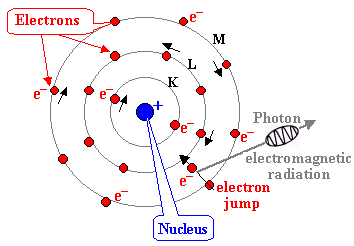 ÞBohr
model
ÞBohr
model
| Electrical
fusion of atoms Þ all the diversity of substances in our
world |
The "boss" of
an atom is the atomic nucleus :
The structure and properties of the atom are given by the
structure of its nucleus
- the number of Z protons in the nucleus determines the electronic configuration of the shell and the occupation of the valence
shell -
Core dimensions: » 10 -13
cm (100,000 times smaller than an atom!), Density r» 10 14
g / cm 3
ß
Hopelessness of medieval alchemy's efforts to transmutate
elements !
(they had no idea
about the nucleus, they "scraped" atoms only on the
valence shell)
Paradox: alchemists were often also
astronomers - they had no idea, that stars that
observe at night, can do
what they try in vain on a large scale for billions of years!
Nuclear physics:
structure of atomic nuclei, strong and weak (nuclear)
interactions


All the diversity of species and
structures of atomic nuclei, their excitation and
radiation as well as nuclear reactions,
nuclear physics explains by the idea of
protons and neutrons occupying
certain energy levels
in the field of nuclear forces .
|
Understanding
the properties of elementary particles
- leptons, baryons, hadrons
- quarks, gluons ...
- particles - antiparticles
Unitary field
theory
electroweak interaction - GUT (grandunified theory) - Supergravity - Superstrings
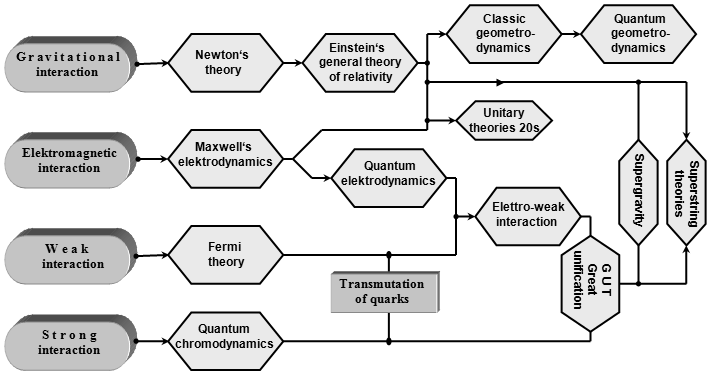
Scheme various stages and processes
unification of four fundamental interactions in nature (see more
datail §B.6 "Unification of fundamental interactions. Supergravity.
Superstrings." in
book "Gravity, black holes, and space - time
physics").
Radioactivity and nuclear
reactions
- spontaneous nuclear
transformation - radioactivity
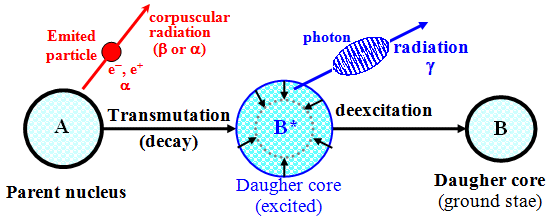
- properties of
ionizing radiation a , b , g
- radiation detection
and spectrometry
- production of
radionuclides by nuclear reactions

Reaction (n, g) - slow neutron radiation capture -
production of b-
emitters in the reactor
99Mo(® 99mTc), 131J, 59Fe, 60Co,
137Cs, 133Xe, ......
Reaction (p, g) - production of b+-radiators in accelerator
(cyclotron)
201Tl, 67Ga, 111In,
81Rb(® 81mKr), 18F, 15O, 11C
........
Industrial use of radiation
Defectoscopy, X-ray fluorescence analysis, neutron activation
analysis ...
Biological use of radiation
- X-ray radiodiagnostics
- radiotherapy
- nuclear medicine
radionuclide diagnostics (especially scintigraphy)
therapeutic applications of radionuclides (eg thyroid 131J)
- nuclear magnetic resonance
Binding energy of
nucleons in nuclei ® nuclear energy

Energy
recovery from atomic nuclei - Nuclear energetics

- fission of uranium
in reactors
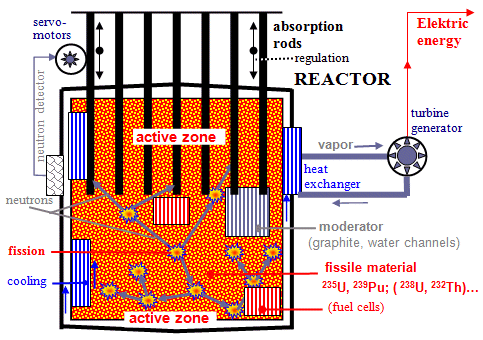
235 U + n ® » 140
X + » 90 Y + (2-3) n (+ 200 MeV); 238 U
+ n ® 239
U ® ( b - ) 239
Pu ® fission .....
- about 0.9 MeV / nucleon is released Þ efficiency: < 0.1% from E = mc 2
- nuclear fusion -
thermonuclear reaction H ® He (+ 25 MeV)

Inertial (laser) fusion Fusion in magnetically held plasma -
tokamak
- about 7 MeV / nucleon is released Þ efficiency: » 0.7% E = mc 2
Our
terrestrial efforts to use nuclear energy are just clumsy
attempts
to emulate what stars have been able to do for billions of years!
What are we missing? - Strong gravity.
Basic
question :
Where did the
elements come from in nature ?
All
the elements God created "with his hands" at
the same time as the creation of the world,
or :
All the elements were created at the origin of the
universe .
(and since then they only
merge with each other) |
When
the universe was created, only the simplest elements were
created,
more complex (heavier) elements were created gradually
during the evolution of the universe:
-
cosmic nucleogenesis - |
ASTROPHYSICS
- physical phenomena in universe
Nuclear
astrophysics
Application of the laws and phenomena of
nuclear physics to processes taking place in universe
COSMOLOGY - structure and evolution of the
universe as a whole
| Origin, development and end of the closed universe : |
|
 |
Early
universe - the "big bang" - hadron era
ß
lepton era - primordial nucleosynthesis
ß
era
radiation
ß
era substances - formation
of
clusters of galaxies, galaxies, stars
ß
Another nucleosynthesis takes place until in the stars The
end of the universe:
open universe Þ thermal death
closed
universe Þ
big
crunch
Hidden matter:
“Brown
dwarfs”?
Black holes?
Neutrinos (rest mass?) ?
Other
"exotic" particles?
|
Pre - big-bang phase + big
bang itself: neither
nucleons nor nuclei of atoms existed.
1. Hadron era
~ 10 -6 s
<t ~ 10 -4 s, r > 10 14 g / cm 3 , T> 10 12 °K
The majority of matter in space was formed by a mixture of
emerging and annihilating heavy particles and
antiparticles with a strong interaction (protons, neutrons,
mesons, hyperons - ie hadrons), whose number was about the same
as photons and neutrinos; there is a thermodynamic equilibrium
between all these particles. The strong
interaction between hadrons plays a dominant role here .
Baryon asymmetry : an excess of
nucleons, about 1 baryon per 108 particles.
Particle formation
H
1 |
- only protons - hydrogen nuclei |
|
| |
|
|
|
|
|
|
|
|
| |
|
|
|
|
|
|
|
|
| |
|
|
|
|
|
|
|
|
|
|
|
|
|
|
|
|
|
2. Lepton era
~ 10 -4 s
<t <~ 10 s, ~ 10 14 g / cm 3 > r > ~ 10 4 g / cm 3 , ~ 10 12 > T> ~ 5.10 9 °K
When the temperature drops so much, that kT ( k is
Boltzman's constant) is significantly lower than the resting
energy of the proton, nucleons and antinucleons annihilate
each other (due to baryon asymmetry except for the small surplus
of nucleons, which led to the formation of the substance now in
space); the mass of the universe then mainly consisted of an
equilibrium mixture of light particles -
photons, electrons, positrons, neutrinos and antineutrinos.
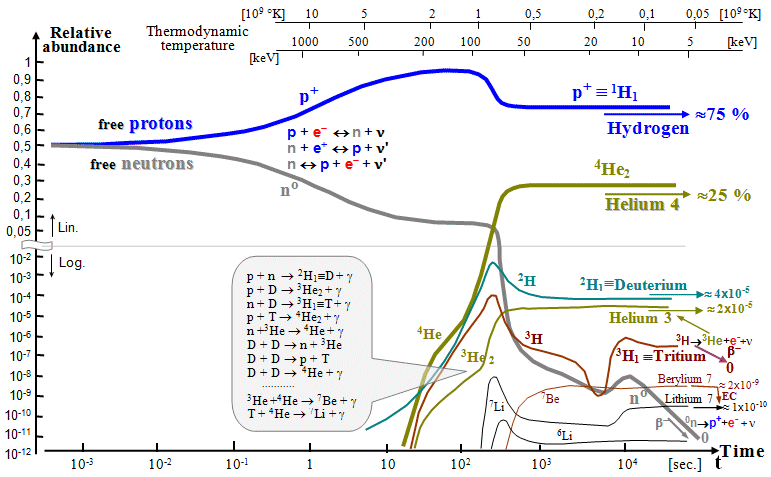 |
The Lepton era free neutrons are
unstable
-
"rescue" of neutrons in helium -
ß
primary
nucleosynthesis
|
H
1 |
75%
hydrogen H, 25% helium He |
He
2 |
| |
|
|
|
|
|
|
|
|
| |
|
|
|
|
|
|
|
|
| |
|
|
|
|
|
|
|
|
|
|
|
|
|
|
|
|
|
3. Radiation era ~ 10 s <t <~ 10 13 s @ 300,000 years, ~ 10 4 g / cm 3 > r > ~ 10 -21 g / cm 3 , ~ 10 10 °K> T> 3.10 10 °K
At the beginning of this stage (also called the
radiation-dominating era of the photon plasma), the synthesis of
helium and the annihilation of electrons with positrons are still
complete. When the energy of the primary photons dropped below
0.5 MeV, which corresponds to the rest energy of the electron,
the radiation ceased to have a significant effect on the further
evolution of the elements in universe.
- from the point of view of
nucleosynthesis, nothing happens
4. The era of matter (post-recombination period),
which begins with the completion of
recombination (approximately 300 00 years
after the Big Bang) and continues to this
day. The temperature of the substance , which
becomes the main carrier of energy-mass, decreases as a-2 during expansion and
should currently reach only about 10 -2 °K; the temperature of the separated "relic"
radiation, changing as a-1, dropped from the original 3000 °K to today's about
2.7 °K. The expansion of the universe transformed what was once
light into microwaves.
 |
Formation of large-scale
structure of the universe ß
The formation of
galaxies and clusters of galaxies
ß
Stars formation
|
The story of
cosmic nucleogenesis continues and graduates !
or
Thermonuclear reactions inside stars
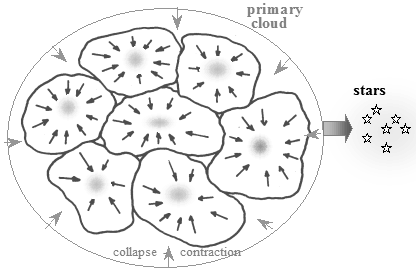 |
Districts can form in a shrinking
cloud in which gravitational contractions occur faster
than in the surroundings (gravitational instabilities).
From these individual districts, protostars are formed
and finally stars, which usually form in groups. |
Thermonuclear reactions as a
source of energy for stars

Hydrogen combustion H ® He (star on the main sequence in HR
diagram)
a) direct proton-proton
reaction (p = 1 H)
1st partial reaction: 1 H + 1 H ® 2 D + e +
+ n (+
1.44 MeV)
2nd partial reaction: 2 D + 1
H ® 3
He + g (+
5.49 MeV)
3rd part Reaction: 3 He + 3 He ® 4 He +
2 1 H (+ 12.85 MeV)
Total energy balance:
release 26.2 MeV = 4.2.10 -12 J
/ core He
b) CNO cycle
1st partial reaction: 12 C + 1 H ® 13 N + g (+ 1.95 MeV)
2nd partial
reaction: 13 N ® 13 C +
e + + n (+ 2.22 MeV)
3rd partial reaction: 13 C + 1
H ® 14
N + g (+
7.54 MeV)
4th partial reaction: 14 N + 1
H ® 15
O + g (+
7.35 MeV)
5th partial reaction: 15 O ® 15 N +
e + + n (+ 2.71 MeV)
6th partial
reaction: 15 N + 1 H ® 12 C +
4 He (+ 4.96 MeV)
Total energy balance:
release 25.0 MeV = 4.0.10 -12 J
/1 core He
General :
The binding energy of each proton in the He nucleus is
0.007 m0.c 2
Þ Thermonuclear hydrogen
combustion efficiency: » 0.007 m0.c 2 ( » 0.7% )
Helium combustion He ® C
(reaction 3 a ® 12 C + g )
4 He + 4 He ® 8 Be +
g
8 Be + 4 He ®
12 C + g (+ 7.4 MeV)
Combustion of carbon C ® O , oxygen, ..... ( a - processes)
May continue at rising
temperature: (if there is still enough helium)
12 C + a ® 16 O + g (+ 7.15 MeV)
16 O + a ® 20 Ne + g
(+ 4.75 MeV)
20 Ne + a ® 24 Mg + g
(+ 9.31 MeV)
etc. ......
- Nucleosynthesis of
heavier elements
¨ a - process: the capture of particles a , reacting
(a , g) - typically up to 40
Ca
¨ neutron capture ; subsequent b- - decay :
N A Z + n 0 ® N + 1 B Z
+ g ; N
+ 1 B Z (b -
) ® N + 1 C Z + 1 +
e - + g
Slow capture n0 (s-process -
proceeds slower than b-decay); - up to N = 210
Rapid capture of neutrons
(so-called r -process - repeated
capture, faster than b-decay); - mostly
in the final stages and during a
supernova explosion
(and also in the nucleonization of neutron
matter ejected during neutron star collisions)
...
The
thermonuclear reaction ends with lighter elements (eg
Mg).
The synthesized elements remain gravitationally trapped
inside the white dwarf
- not relevant for cosmic nucleosynthesis - |
| Massive stars (M >
6M ¤ ) : |
The whole
sequence of thermonuclear reactions takes place, down to
iron .
Supernova
explosion Þ ejection of synthesized elements +
formation of heavy elements
-
driving force of cosmic nucleosynthesis - |
Nucleosynthesis up to Fe - exothermic process
Nucleosynthesis over Fe - endothermic reactions -
takes place only in the final stage of stars
H
1 |
ß upper layers of a star à |
He
2 |
Li
3 |
Be
4 |
ß middle layer of the star à |
B
5 |
C
6 |
N
7 |
O
8 |
F
9 |
Ne
10 |
Na
11 |
Mg
12 |
å centrum area of
star c |
Al
13 |
Si
14 |
P
15 |
S
16 |
Cl
17 |
Ar
18 |
K
19 |
Ca
20 |
Sc
21 |
Ti
22 |
V
23 |
Cr
24 |
Mn
25 |
Fe
26 |
Co
27 |
|
|
|
|
|
|
|
|
|
| |
|
|
|
|
|
|
|
|
|
|
|
|
|
|
|
|
|
| |
| Stars
- alchemical cauldrons of universe |
How do the
heavier elements "cooked" by the star get into the
surrounding universe ?
or
The final stages of the life of the stars
White dwarf (if the remaining mass of the star is < 1.5 Sun)
End of a massive star: M Supernova explosion
- 1st consequence:
ejection of synthesized elements (up to iron)
Pushing e- into nuclei,
absorbing them and merging with p+ (K-capture
analogy)
e - + p + ® n
0 + n (+ g ) Þ neutron
star (at
M < 2 M¤)
explosion Þ ejecting heavier elements
from the interior of the star into surrounding space
- Consequence 2:
synthesis of heavy elements (up to transurans)
Huge number of neutrons Þ repeated neutron fusion Þ formation of even the most
heaviest elements
neutron capture ; subsequent
b- - decay :
N A Z + n 0 ® N +
1 B Z + g ; N + 1
B Z (b -
) ® N + 1
C Z + 1 + e -
+ g ; etc ... etc ... etc ...
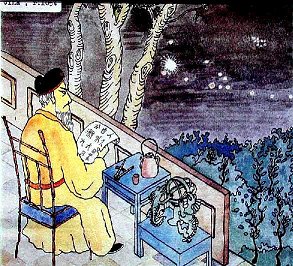 |
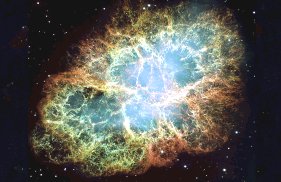 |
| Supernova explosion observed in 1054 in China |
Today, a Crab Nebula containing a
pulsar inside - a rapidly rotating neutron star - is
observed at that place |
| |
H
1 |
Supernova explosion: |
He
2 |
Li
3 |
Be
4 |
the emergence of even the
heaviest elements |
B
5 |
C
6 |
N
7 |
O
8 |
F
9 |
Ne
10 |
Na
11 |
Mg
12 |
(incl. transurans and
radioactive isotopes) |
Al
13 |
Si
14 |
P
15 |
S
16 |
Cl
17 |
Ar
18 |
K
19 |
Ca
20 |
Sc
21 |
Ti
22 |
V
23 |
Cr
24 |
Mn
25 |
Fe
26 |
Co
27 |
Ni
28 |
Cu
29 |
Zn
30 |
Ga
31 |
Ge
32 |
As
33 |
Se
34 |
Br
35 |
Kr
36 |
Rb
37 |
Sr
38 |
Y
39 |
Zr
40 |
Nb
41 |
Mo
42 |
Tc
43 |
Ru
44 |
Rh
45 |
Pd
46 |
Ag
47 |
Cd
48 |
In
49 |
Sn
50 |
Sb
51 |
Te
52 |
I
53 |
Xe
54 |
Cs
55 |
Ba
56 |
La .. î
|
Hf
72 |
Ta
73 |
W
74 |
Re
75 |
Os
76 |
Ir
77 |
Pt
78 |
Au
79 |
Hg
80 |
Tl
81 |
Pb
82 |
Bi
83 |
Po
84 |
At
85 |
Rn
86 |
Fr
87 |
Ra
88 |
Ac .. î
|
Rf
104 |
Db
105 |
Sg
106 |
Bh
107 |
Hs
108 |
Mt
109 |
Ds
110 |
Rg
111 |
Uub
112 |
Uut
113 |
Uuq
114 |
Up
115 |
Uuh
116 |
Uus
117 |
Uuo
118 |
+ other heavier nuclei +
many radioactive isotopes of all nuclei
(only stable elements and
radioactive ones with only T 1/2 > 10 8 years have been preserved ) |
| |
| Lanthanoids
: |
La
57 |
Ce
58 |
Pr
59 |
Nd
60 |
Pm
61 |
Sm
62 |
Eu
63 |
Gd
64 |
Tb
65 |
Dy
66 |
Ho
67 |
Er
68 |
Tm
69 |
Yb
70 |
Lu
71 |
| Actinoids : |
Ac
89 |
Th
90 |
Pa
91 |
U
92 |
Np
93 |
Pu
94 |
Am
95 |
Cm
96 |
Bk
97 |
Cf
98 |
Es
99 |
Fm
100 |
Md
101 |
No
102 |
Lr
103 |
Fusion
of neutronon stars
Another way of creating heavier elements in space
occurs with the close orbit of two neutron stars
and their merging - fusion, "collision". In this
process, a large amount of neutron matter is ejected,
which immediately "nucleonizes"
to form atomic nuclei (§4.8, passage "Collisions
and fusions of neutron stars") :

This creates a large number of cores, with a relatively higher
proportion of heavy elements. Due to the huge
number of neutrons, the r-process of rapid
repeated neutron capture by lighter nuclei takes
place intensively, during which very heavy nuclei
are also effectively formed - from the area around iridium,
platinum, gold, to a group of uranium.
 |
Relative abundance of elements in
nature depending on their proton (atomic) number Z,
related to hydrogen Z = 1.
Above: The current
average representation of elements in universe. Bottom:
Occurrence of elements on Earth (in the Earth's crust)
and terrestrial planets.
Due to the large range of values, the
relative representation of the elements (relative to
hydrogen Z = 1) on the vertical axis is plotted on a
logarithmic scale; however, this can optically distort a
large difference in the representation of hydrogen and
helium compared to heavier elements, especially in the
upper graph. |
In terms of origin,
all elements can be divided into 3 groups :
- I. Primary (primordial)
Hydrogen
+ Helium - "children"
of the big bang (hydrogen
"firstborn", helium about 3 min younger)
- II. Secondary (stellar)
Carbon,
nitrogen, oxygen, ..., iron, ..., uranium - the "grandchildren" of the
Big Bang , the children of the stars ;
began to form after about 200 million years after
the Big Bang - the heavier, the younger -
- III. Tertiary
(cosmogenic)
Lithium, beryllium,
boron - distant descendants of the
Big Bang: they are formed until later, only by the
interaction of cosmic radiation with the
already formed heavier elements scattered in space .
| General
mass distribution: |
 |
| Mass:
|
e material - particle, atomic structure |
| î field - distributed form of matter (quantized) |
Matter in space:
|
e
the observed luminous + lightless - baryonic |
î non-radiant - dark
(hidden) matter
â c |
| |
í dark matter î |
dark
energy ? |
| |
baryonic
? nonbaryonic |
( nonbaryonic
) |
According
to current estimates, it is in universe :
about 73% dark energy ; about 23%
dark matter (hidden, non-radiant);
only » 4% of ordinary matter
" luminous"or absorbing, accessible to
observation . |
|
We are dealing
here with the evolution of baryon matter
composed of protons, neutrons and electrons
| Physical stage |
Nuclear-chemical stage |
Chemical stage |
Biological stage |
Origin of the universe - big bang
4 physical interactions
Origin of fields and particles
Gravity - structure of the universe |
Nuclear reactions of particles
Nucleosynthesis of elements
Expansion of elements into space |
Recombination
- formation of atoms -
Formation of compounds |
Hydrocarbon reactions
Pre-biotic reactions
Cell formation
Evolution of organisms |
“We
are all descendants of the stars! "
Every atom of carbon, oxygen, nitrogen, sulfur, ... etc.,
in our body
once formed inside an ancient star
- (star now
already burnt out, partly exploded, or collapsed into a
neutron star or black hole) |
Earthly
destinies of elements :
Formation
of the solar system and planet Earth
ß
selection mechanisms Þ
other relative
representation of elements in our nature
Gravitational
selection factor: higher
proportion of heavier elements on planets
|
Helium -
element of the Sun God |
He - the second most abundant
element in the universe (25%)
Inert light gas, the gravity of the Earth will not keep it Þ rare on
Earth.
First discovered not on Earth but on the Sun! - ( Helios = ancient Greek sun god
).
(P.Janssen 1868 - the spectral lines of
sunlight - unknown "solar" element)
All helium on earth has secondary origin: originated by the a-radioactivity
of uranium and thorium
(accumulates in underground premises, along with natural gas)
Time
selection factor: all radioactive nuclei with
T1/2 <
108 years
have already decayed
(long-term primary
radionuclides - potassium 40K, thorium 232Th, uranium 235,238U - have been
preserved )
>
Rare and
artificial elements >
Actinides (except thorium and uranium), especially transurans ® radioactive Þ have not been preserved ;
they are produced artificially by nuclear reactions
.
Discoveries of new transurans - up to Z = 118 (ununoctium).
Exception from the middle of Medeleev's table: technetium Tc43 -
does not have a stable isotope.
All these elements are now created artificially
- in nuclear reactors or accelerators.
Cosmogenic
elements
The interactions of cosmic
radiation with interstellar matter
and the Earth's atmosphere cause a number of of nuclear
reactions Þ produced cosmogenic
elements .

Cosmogenic elements: deuterium , lithium , beryllium , boron - formed by fission of heavier nuclei by hard cosmic
radiation
Cosmogenic radionuclides: carbon
14C
, tritium 3H (+ trace amount 7,10Be, 32P, 35S, 36Cl
)
Appendix 1: Black holes
At M > 2 M ¤ : Complete relativistic gravitational
collapse of star Þ
black
hole
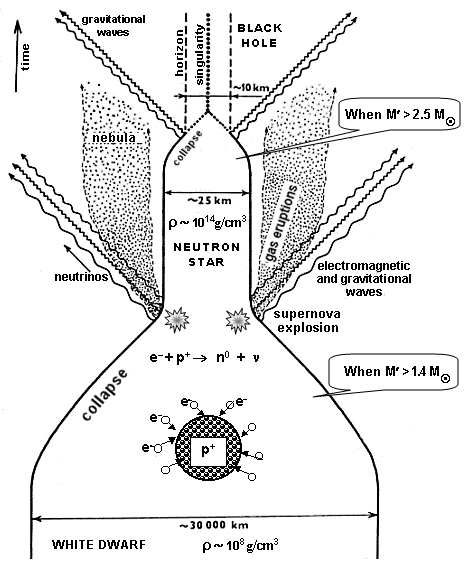
The theorem " black hole has
no hair "
Quantum evaporation
of a black hole (Hawkin's process)

The Black Hole ® is the
place where
nuclear physics ends
!
The physics of black holes is
discussed in detail in Chapter 4 "Black
Holes" of the book "Gravity,
Black Holes and the Physics of Spacetime".
Appendix 2: Microphysics and
cosmology
4 types of interactions in nature :
- Gravitational
- Electromagnetic
- Strong (nuclear) interaction
- Weak (nuclear) interaction
The speculative question :
“ What would happen if God
canceled ("turned
off") different types of interactions? ”
For a more detailed discussion, see the passage "4
types of interactions in nature",
chapter 5 "Elementary particles", in the monograph
"Nuclear physics and physics of ionizing radiation" .
Relationship between
microphysics and cosmology :
Relativistic cosmology is discussed in
detail in Chapter 4 "Cosmology" of the book "Gravity,
Black Holes and the Physics of Spacetime".
Unitary theory of fields and particles is discussed in Chapter B
"Unitary
theory of fields" of the same
monograph .
Vojtech Ullmann


 ÞBohr
model
ÞBohr
model 













